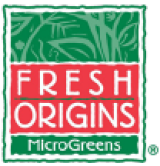


Petite® Oregano
Estimated Inventory, 4 oz : 0
This item was last sold on : 12/01/22
| Fresh Origins | Homepage |
Description/Taste
Petite® Oregano is comprised of 2 to 8 small oval to lanceolate leaves attached to slender, straight stems. The leaves are broad and flat, bearing smooth and even curved edges and faint veins can be softly seen branching through the center. The dark green leaves and stems are also enveloped in a light coating of fuzz, giving the surface a slight silvery tone. Petite® Oregano is crisp and tender with a succulent consistency. The leaves contribute a bold, earthy, and herbaceous flavor, with an initially sweet taste on the palate followed by a peppery bitterness.
Seasons/Availability
Petite® Oregano is available year-round.
Current Facts
Petite® Oregano is a part of a specialty line of boutique edible greens grown by Fresh Origins Farm in San Diego, California. Petite® Greens are more mature versions of microgreens, harvested approximately 4 to 6 weeks after sowing, and Fresh Origins currently grows over 125 varieties in-house. Petite® Oregano is an innovative creation developed for chefs to reimagine the way oregano is used in culinary dishes. Oregano is an ancient herb utilized in culinary preparations for thousands of years. The name oregano is derived from two Greek words, “oros,” meaning “mountain,” and “ganos,” meaning “joy.” Like its name, oregano has a robust flavoring that sparks emotional responses when used in dishes, but the herb has been traditionally used dried. Incorporating tender and fresh Petite® Oregano modernizes dishes and captures a unique vegetal flavoring in a compact, edible green. Chefs value Petite® Oregano for its ability to add color, flavor, and texture to culinary preparations. Petite® Oregano should be used in limited quantities and offers bold flavors in a small package to create a lasting impression. In addition to Petite® Oregano, Fresh Origins also offers Micro Oregano as a younger, more delicate alternative.
Nutritional Value
Petite® Oregano has not been studied for its nutritional properties. Like mature oregano leaves, Petite® Oregano is a source of vitamin K to assist with faster wound healing, fiber to regulate the digestive tract, calcium to protect bones and teeth, manganese, and iron. The leaves also contain antioxidants to guard the cells against free radical damage and essential oils with compounds known as thymol and carvacrol. These natural chemicals give the oregano its specific flavor profile. The compounds have anti-bacterial and anti-fungal properties.
Applications
Petite® Oregano has a robust flavor well suited as an unexpected fresh element in savory preparations. The greens are commonly incorporated raw at the end of the cooking process, and a little of the herb goes a long way. Petite® Oregano can be combined with dry oregano in dishes to create a complex, enhanced flavor, and the leaves can be lightly torn and tossed into salads or infused into oils, dressings, vinaigrettes, and marinades. The greens can also be gently folded into stuffing, chopped and mixed with grilled, roasted, or fried vegetables, stirred into soups, or served with grilled meats. Petite® Oregano complements flavors found in Mediterranean cuisines, especially in Italian, Turkish, and Greek. The fresh leaves can be incorporated into pasta, sauces, slow-roasted peppers, and rice dishes. They are also used by chefs in Mexican dishes such as salsa, enchiladas, soups, and albondigas. Petite® Oregano pairs well with cheeses such as mozzarella, feta, and cheddar, cucumbers, tomatoes, bell peppers, sweet potatoes, carrots, zucchini, meats including lamb, poultry, beef, and pork, and seafood such as fish, mussels, shrimp, and clams. Petite® Greens will generally keep up to seven days when stored unwashed, dry, and in a container in the refrigerator. It is recommended to use Petite® Oregano immediately for the best quality and flavor.
Ethnic/Cultural Info
In the United States, oregano achieved commercial success after World War II and became a beloved culinary herb. From 1943 to 1945, thousands of American soldiers invaded Sicily and Southern Italy, living off rations and available local cuisine, including wild oregano growing in nearby hills. When the soldiers returned home, they began craving the exotic flavors of Italian cooking and searched the American culinary scene for chefs who could make pizza and pasta flavored with oregano or the “pizza herb.” The destruction of Italy during World War II also led many Italian immigrants to move to the United States, where they opened eateries featuring a piece of their home cuisine. Italian food exploded in popularity across the United States in the 1950s and 1960s, establishing oregano as a staple herb in household kitchens. During this time, oregano also became one of the most imported herbs, averaging 1.5 million pounds per year. Today oregano is still a central component in Italian-American cooking, and the woodsy, earthy, and fresh herb has expanded to be featured in cuisines worldwide.
Geography/History
Petite® Oregano was developed at Fresh Origins Farm in San Diego, California, the leading American producer of naturally grown microgreens and Petite® Greens since the mid-1990s. Fresh Origins has been using the mild Southern California climate year-round to produce robust, healthy, and flavorful Petite® Greens, and the farm closely partners with chefs to create innovative varieties with unique flavorings. Fresh Origins also has the highest level third-party-audited food safety program and is a certified member of the California Leafy Greens Marketing Agreement, which follows science-based food safety practices to promote transparency and honesty in production. Today Petite® Oregano can be found through select distribution partners of Fresh Origins across the United States, including Specialty Produce, and are also found through partners in Canada.




 Learn More...
Learn More...
